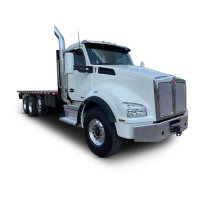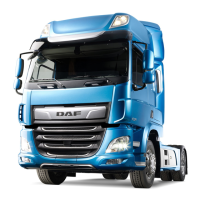
Do you have a question about the Paccar Peterbilt 520EV 2022 and is the answer not in the manual?
Provides guidance on how to use the operator's manual for safe and efficient operation.
Explains safety alerts, symbols, and signal words like DANGER, WARNING, CAUTION, NOTE.
Defines danger warnings and their implications for injury, death, or damage.
Defines warning messages and their implications for injury, death, or damage.
Defines caution messages and their implications for minor injury or damage.
Explains how to interpret important information that is not safety-related but useful.
Explains that illustrations may be generic and not exactly match the vehicle's components.
Highlights important safety notices for operating and servicing the vehicle.
Details California Proposition 65 warnings regarding lead and other chemicals.
Explains the disclosure of recording devices (event data recorders) in the vehicle.
Contains specific warnings about repairs, modifications, and electronic device installation.
Warns about operating the vehicle within its capabilities and awareness of noise.
Refers to the 520 Operator's Manual for guidance on vehicle loading.
Describes the air compressor driven by an electric motor.
Describes the air conditioning compressor driven by an electric motor.
Explains how the cab heater uses propulsion battery power.
Details the DC fast charger and optional AC charger.
Explains the chiller's role in maintaining battery temperature.
Describes the function of coolant pumps in circulating coolant.
Explains the DC-DC converter's function as an alternator equivalent.
Provides the differential ratio for the eAxle.
Mentions the 2-speed or 3-speed transmission for the eAxle.
States the power steering pump is driven by its own motor.
Notes that powertrain fans are driven by electric motors.
Explains the propulsion motor and inverter's function in converting DC to AC voltage.
Discusses the high voltage battery packs and their maintenance.
Identifies additional components within the Power Electronics and Controls Subsystem.
Provides contact information and services for roadside assistance.
Offers instructions for first responders, including a QR code for documentation.
Outlines steps to follow in case of an accident or emergency.
Provides warnings and instructions for towing the vehicle safely.
Details the specific steps for towing the vehicle with its wheels on the ground.
Explains the procedure and safety precautions for jump-starting a battery.
Provides detailed steps for connecting and disconnecting jumper cables for jump-starting.
Offers warnings and instructions for recovering a vehicle, especially from precarious positions.
Directs users to other sections for fuse replacement information.
Shows and describes the gauges in the vehicle's center cluster.
Explains symbols for "Ready to Move" and "PTO" on the electric truck.
Details telltales indicating charging status and potential interlocks.
Explains the telltale for Power Take-Off (PTO) status and errors.
Describes telltales for service needs, limited performance, and derated systems.
Explains the RBS telltale and its relation to braking and battery state.
Explains the telltale indicating a high voltage hazard and required actions.
Describes the power output gauge and its relation to economy and range.
Explains the battery state of charge and auxiliary power loss gauges.
Notes that trip and truck information menus are limited or disabled for this vehicle.
Discusses HVAC functions and the use of battery power for heating.
Explains the retarder switches for regenerative braking and their settings.
Notes the absence of fan override and aftertreatment switches on this model.
Describes the gear selector and the +/– buttons for manual shifts.
Details checks to ensure the park brake is engaged and transmission is in neutral.
Guides on inspecting the vehicle's exterior and components before driving.
Provides warnings and instructions for inspecting the PCAS (Power Electronics and Controls Subsystem).
Outlines the steps for starting the vehicle and verifying readiness.
Details the steps for safely shutting down the vehicle.
Illustrates the park brake knob positions for applied and released states.
Describes the DC fast and AC charge ports and their compliance.
Provides warnings and steps for connecting the truck to a charger.
Explains how to disconnect the charger, including when the battery is not at 100%.
Lists minimum daily checks drivers should perform on the vehicle.
Details specific daily checks for powertrain components like coolant and cables.
Refers to the 520 Operator's Manual for chassis/exterior checks and label replacement.
Guides on checking the battery gauge and cluster indicators in the cab interior.
Provides warnings and cautions regarding coolant levels, lubricants, and welding.
Restricts high voltage part maintenance to qualified personnel only.
Gives warnings and cautions about washing the truck and its components.
Summarizes battery EV storage requirements based on duration, environment, and temperature.









